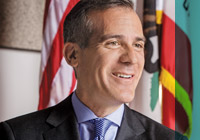To those envisioning the Los Angeles of the future, the present poses a problem. Year after year, as measured in the UCLA Luskin School’s quality of life survey, headed by former County Supervisor Zev Yaroslavsky, residents consistently cite the protection of their own neighborhoods as an idea they value very highly; they regularly rank italongside race relations and health care as among those things people here most strenuously care about. This year is no exception.
How should a planner interpret that response? What if certain kinds of development — multi-family, with simple access to public transportation — would improve race relations, decrease traffic and improve the environment, but challenge the historic character of some communities?
That’s the rub. According to this latest survey, more than two-thirds of Angelenos would prefer to limit new apartment construction to parts of the city that already are zoned for multi-family units. There are distinct differences by age on that question — younger people are more accommodating of apartment buildings — but even younger residents question the wisdom of adding apartments in some communities. This is in a larger context of a poll that finds growing concerns about the cost of living in Los Angeles — especially among young people.
It’s not that community preservation is necessarily racial — most, in fact, is not. But resisting change is fundamentally conservative, so community protection can come at the expense of diversity. And what’s good for small communities may not be the best course for a major city. Some parochial interests must give way if Los Angeles is to meet its other demands — increasing independence from fossil fuels, a more efficient transportation network and real-life, nose-to-nose racial integration.
This does not mean that Los Angeles is en route to becoming Manhattan — or that Manhattan is the gold standard of responsible development. Los Angeles is too big, too diverse, too interesting to become Manhattan. It’s en route to becoming itself, not a copy of something else. And it’s the attitudes of those who live here that will determine what the future looks like — hence the importance of this annual poll.
Los Angeles has another saving grace: It is really, really big. Density downtown or along the Wilshire Corridor or in Westwood doesn’t impinge on the single-family homeowner in Sherman Oaks or Baldwin Hills. There is room within this city for both waves of apartment construction and single-family homes. In fact, as Bill Boyarsky’s piece in this issue suggests, there’s demand for both.
More housing is needed in Los Angeles because people want to live here. That’s a good thing. Most of the growth will occur in transit corridors and areas already amenable to high-rise, multi-family construction. That’s good, too, and, if properly considered by the city’s leadership, it will create vibrant stripes of urban life while preserving single-family homes and established communities. We can have subways and swimming pools, but only if we insist that leaders demand both. This poll makes it clear that they can.
























